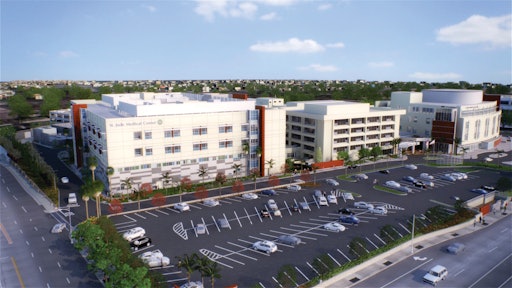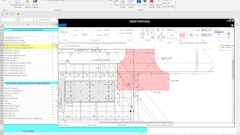
The design/build team of McCarthy Building Companies, Inc., and TAYLOR, are working with St. Joseph Health System to build a new patient tower, parking structure and central utility plant at the St. Jude Medical Center in Fullerton, CA. Located on the northern side of the existing medical campus at Bastanchury Road and Harbor Boulevard, site preparation has been underway since December 2010, and the new tower officially broke ground during a private ceremony on September 25, 2011.
An integral part of the St. Jude Medical Center’s multi-phased Master Plan, the $285.4 million project includes construction of a 200,000-square-foot, four-story acute care building with a connecting bridge to level four of the existing hospital building and a 14,000-square-foot central utility plant. Along with architect International Parking Design of Irvine, CA, McCarthy is also adding 215 parking spaces to an existing 455-car parking structure that the firm built in 2004.
Demolition and relocation
Prior to construction of the new tower, McCarthy performed seven months of major utility work and is demolishing an existing medical records building and parking garage. New surface parking and street improvements including redevelopment of a cul-de-sac, addition of right-turn lane, street widening and extension of a center median are also being conducted.
According to Todd Foos, McCarthy project manager, one of the biggest challenges on the project thus far has been relocating all of the hospital’s utility services prior to the demolition of the existing parking structure and construction of the new tower.
“We worked closely with the hospital to devise a plan that enabled us to complete this sensitive infrastructure work while mitigating disruption to the existing hospital,” explained Foos. “Additional challenges will be maintaining access to the existing hospital’s loading dock. In order to meet this requirement, we will be constructing a temporary road through the foundation of the new building which will be in place until February or March 2012.”
In order to meet strict California seismic regulations in compliance with Senate Bill 1953, the 120-bed patient tower is being built with a lateral force resisting system consisting of buckling restrained braced frames (BRBF) with moment resisting beam to column connections. In addition, a lateral foundation system is being built with continuous anchor caps in conjunction with tie-down anchors.
BIM aids sustainable design
The modern design of the Northwest Tower was developed within a Project Design Charter, which was created to guide design decisions toward a simple functionality that appropriately meets future needs and provides the latest technology for staff and patient care.
In keeping with the social sustainability goals of the project, the new tower incorporates many environmentally sustainable features such as an energy efficient building envelope, which incorporates high-performance window glazing, sunshading and well-insulated walls and roof. Mechanical systems also improve energy efficiency by utilizing a 100% outside air system with heat recovery that yields superior indoor air quality and infection control.
“Building a state-of-the-art hospital with complex mechanical, electrical and plumbing (MEP) systems requires the utilization of latest advancements in design and construction technology as well as an experienced and collaborative team,” said Patrick Peterson, McCarthy project director.
“To meet the challenges of this complex project on an operational medical campus, we are utilizing a combination of Integrated Project Delivery (IPD) and design/build methods to collaboratively harness the talents and insights of all team members and to optimize efficiency through all phases of design, fabrication and construction,” explained Peterson.
TAYLOR, McCarthy and key subcontractor partners are using the following Building Information Modeling (BIM) tools for design and coordination: Revit Architecture, Revit Structures, Revit MEP, AutoCAD MEP 3D, AutoCAD Civil 3D, CADmech, CADpipe, NavisWorks and Google Sketch-up.
“Utilizing these combined BIM applications with an integrated team delivery approach not only will help to identify challenges before they become on-site problems, but it also provides a greater benefit by allowing the entire design and construction team to create and work from a seamless model throughout all stages of the project,” said Foos. As a result of this collaborative effort, the team has lowered the original target budget by approximately $14.5 million.
"St. Joseph Health System has determined that the best way to understand, evaluate and make decisions at each critical point of the project during design, is through the use of BIM tools. This has streamlined the decision-making process and given us the opportunity to quickly evaluate and analyze “What if” scenarios. The BIM tools are a benefit to all stakeholders on the project team,” explained Jim Bostic, AVP Construction Division, at St Joseph Health System in Southern California.
The St. Jude Northwest Tower project is scheduled to be completed in summer 2014 and open in fall 2014.
About the Design/Build Team:
McCarthy Building Companies, Inc. is the nation’s 10th largest domestic general contractor (Engineering News-Record, May 2011) and is the largest American-based healthcare builder in the country. The firm has completed over $2.4 billion in healthcare work in Southern California alone. In addition to Newport Beach, McCarthy has offices in San Diego, Sacramento and San Francisco, Calif.; Phoenix; Las Vegas; Dallas; Houston; St. Louis and Atlanta. McCarthy is 100% employee owned. More information is available at www.mccarthy.com.
TAYLOR is a full–service architectural and interior design practice focused exclusively on healthcare. With offices in northern and southern California, the 60-person firm has built a strong regional practice with clients including: Children’s Hospital and Research Center Oakland, Oakland CA, Scripps Health in San Diego, CA, Hoag Hospital in Orange County, CA, UCSF Medical Center, San Francisco CA, and Kaiser Permanente. For more information, visit www.TAA1.com.




























